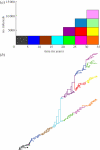A dimensionless number for understanding the evolutionary dynamics of antigenically variable RNA viruses
- PMID: 21543353
- PMCID: PMC3203497
- DOI: 10.1098/rspb.2011.0435
A dimensionless number for understanding the evolutionary dynamics of antigenically variable RNA viruses
Abstract
Antigenically variable RNA viruses are significant contributors to the burden of infectious disease worldwide. One reason for their ubiquity is their ability to escape herd immunity through rapid antigenic evolution and thereby to reinfect previously infected hosts. However, the ways in which these viruses evolve antigenically are highly diverse. Some have only limited diversity in the long-run, with every emergence of a new antigenic variant coupled with a replacement of the older variant. Other viruses rapidly accumulate antigenic diversity over time. Others still exhibit dynamics that can be considered evolutionary intermediates between these two extremes. Here, we present a theoretical framework that aims to understand these differences in evolutionary patterns by considering a virus's epidemiological dynamics in a given host population. Our framework, based on a dimensionless number, probabilistically anticipates patterns of viral antigenic diversification and thereby quantifies a virus's evolutionary potential. It is therefore similar in spirit to the basic reproduction number, the well-known dimensionless number which quantifies a pathogen's reproductive potential. We further outline how our theoretical framework can be applied to empirical viral systems, using influenza A/H3N2 as a case study. We end with predictions of our framework and work that remains to be done to further integrate viral evolutionary dynamics with disease ecology.
Figures




Similar articles
-
Barriers to antigenic escape by pathogens: trade-off between reproductive rate and antigenic mutability.BMC Evol Biol. 2007 Nov 15;7:229. doi: 10.1186/1471-2148-7-229. BMC Evol Biol. 2007. PMID: 18005440 Free PMC article.
-
Vaccines and viral antigenic diversity.Rev Sci Tech. 2007 Apr;26(1):69-90. Rev Sci Tech. 2007. PMID: 17633294 Review.
-
Epochal evolution shapes the phylodynamics of interpandemic influenza A (H3N2) in humans.Science. 2006 Dec 22;314(5807):1898-903. doi: 10.1126/science.1132745. Science. 2006. PMID: 17185596
-
A two-tiered model for simulating the ecological and evolutionary dynamics of rapidly evolving viruses, with an application to influenza.J R Soc Interface. 2010 Sep 6;7(50):1257-74. doi: 10.1098/rsif.2010.0007. Epub 2010 Mar 24. J R Soc Interface. 2010. PMID: 20335193 Free PMC article.
-
Unifying the epidemiological and evolutionary dynamics of pathogens.Science. 2004 Jan 16;303(5656):327-32. doi: 10.1126/science.1090727. Science. 2004. PMID: 14726583 Review.
Cited by
-
Modeling the Growth and Decline of Pathogen Effective Population Size Provides Insight into Epidemic Dynamics and Drivers of Antimicrobial Resistance.Syst Biol. 2018 Jul 1;67(4):719-728. doi: 10.1093/sysbio/syy007. Syst Biol. 2018. PMID: 29432602 Free PMC article.
-
Linear B-Cell Epitopes in Human Norovirus GII.4 Capsid Protein Elicit Blockade Antibodies.Vaccines (Basel). 2021 Jan 14;9(1):52. doi: 10.3390/vaccines9010052. Vaccines (Basel). 2021. PMID: 33466932 Free PMC article.
-
Complex population dynamics and the coalescent under neutrality.Genetics. 2012 Jan;190(1):187-201. doi: 10.1534/genetics.111.134627. Epub 2011 Oct 31. Genetics. 2012. PMID: 22042576 Free PMC article.
-
Genetic mapping of a highly variable norovirus GII.4 blockade epitope: potential role in escape from human herd immunity.J Virol. 2012 Jan;86(2):1214-26. doi: 10.1128/JVI.06189-11. Epub 2011 Nov 16. J Virol. 2012. PMID: 22090110 Free PMC article.
-
Phylodynamic theory of persistence, extinction and speciation of rapidly adapting pathogens.Elife. 2019 Sep 18;8:e44205. doi: 10.7554/eLife.44205. Elife. 2019. PMID: 31532393 Free PMC article.
References
-
- Holmes E. C., Grenfell B. T. 2009. Discovering the phylodynamics of RNA viruses. PLoS Comput. Biol. 5, e1000505.10.1371/journal.pcbi.1000505 (doi:10.1371/journal.pcbi.1000505) - DOI - DOI - PMC - PubMed
-
- Rott N. 1990. Note on the history of the Reynolds number. Ann. Rev. Fluid Mech. 22, 1–1110.1146/annurev.fl.22.010190.000245 (doi:10.1146/annurev.fl.22.010190.000245) - DOI - DOI
-
- Anderson R. M., May R. M. 1991. Infectious diseases of humans: dynamics and control. Oxford, UK: Oxford University Press
-
- Grenfell B. T., Pybus O. G., Gog J. R., Wood J. L. N., Daly J. M., Mumford J. A., Holmes E. D. C. 2004. Unifying the epidemiological and evolutionary dynamics of pathogens. Science 303, 327–33210.1126/science.1090727 (doi:10.1126/science.1090727) - DOI - DOI - PubMed
-
- Andreasen V., Sasaki A. 2006. Shaping the phylogenetic tree of influenza by cross-immunity. Theoret. Popul. Biol. 70, 164–17310.1016/j.tpb.2006.04.004 (doi:10.1016/j.tpb.2006.04.004) - DOI - DOI - PubMed
Publication types
MeSH terms
Substances
LinkOut - more resources
Full Text Sources

